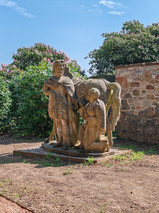Marchmont House: A Celebration of Art, History, and Nature
- Wee Walking Tours
- Sep 28, 2024
- 4 min read
Marchmont House stands as a testament to Georgian elegance. Once the seat of the Earls of Haddington, it has seen centuries of change, from the opulence of the Georgian era to the trials of the 20th century, and finally to its meticulous restoration in recent years. So, join us we head to the Scottish Borders, and explore this beautiful Palladian mansion!

From Georgian Origins to a 21st Century Restoration Success
There has been debate as to the architect who designed Marchmont House. It is thought that the plans were drawn up by the famous Scottish architect, William Adam, but he died before he was able to start his work on the House. However, historians believe that Adams’ plans were executed by the architect, Thomas Gibson, when the building of the house began in 1750. Five years later, the result was an exquisite Georgian house that surely must have pleased Hugh Hume-Campbell, the 3rd Earl of Marchmont. Some of the original magnificent Georgian plasterwork can still be seen in the Saloon (pictured below)
While they had a good run, the Hume-Campbells experienced financial difficulties at the beginning of the 1900s and had to sell Marchmont House in 1912. It was purchased by Robert Finnie McEwen who hired renowned Scottish architect, Sir Robert Lorimer, to make some rather grand renovations to the house from 1914-1917. One of the finest examples can be found in Lorimer’s magnificent oak-panelled Music Room. In addition to the beautifully carved woodwork, the original 1919 organ stands tall and proud- commanding the attention of all as they enter the room.
Several decades later, Marchmont House was eventually sold to the Sue Ryder Foundation in the 1980s to be used as a care home for the elderly. However, by the beginning of the 2000s, it became clear that having such a large mansion was not a financially sustainable option and they decided to sell it. While we are fortunate that the Foundation ensured that the house didn’t fall to ruin as so many grand houses have in Scotland, Marchmont was still in need of serious renovations by the time they put the house up for sale. Enter father/son duo- Oliver and Hugo Burge.
Oliver- who was the managing director for Marchmont Farms- had already purchased approximately 3,000 acres of Marchmont estate in 1988. However, he was not initially interested in purchasing the house. Fortunately, he changed his mind and he and his son, Hugo, decided to take it on and purchased the house in 2006 (along with another 2,500 acres in 2007).

As I mentioned above, Marchmont House was in desperate need of remodelling and Oliver and Hugo took to the task carefully with consultations from various firms including Historic Scotland. What is amazing is that all the art, artefacts, and furniture you now see inside have been relatively recent acquisitions and are not original to the House. It truly is a living museum with carefully curated collections that span 550 years of art history. It was clear during our recent tour that the restoration has been a phenomenal success.
Marchmont House Today
Today, Marchmont House is a fascinating blend of old and new- celebrating art in its many forms. In fact, the House hosts a wide array of musical and artistic endeavours. For example, since 2021, Marchmont has welcomed the Samling Young Artists Programme. The Programme consists of week-long residential courses that provide a variety of performers including singers, pianists, and conductors, opportunities to learn from world-class teachers. I can only imagine how inspiring it must be to study among such grand surroundings.

There are also concerts held at Marchmont House. This past summer they held the Stanford Centenary Weekend celebrating the composer, Sir Charles Villiers Stanford. Stanford was a friend of Robert Finnie McEwen and visited Marchmont often. In fact, he consulted on the acoustics of the Music Room and the specification of the organ.

The celebration of the arts continues outside throughout the grounds of Marchmont House. Let’s head out for a wee walkabout.
Warrior Queen, Gods, and More
As you wander around the estate, you take in a tranquil atmosphere that includes not only the beautiful nature of the region, but also unique sculptures that span the centuries. One of my favourite sculptures was the 'Warrior Queen'.

Visiting Marchmont House
The current owners, dedicated to preserving the House's heritage, have ensured that every corner of the estate tells a story. From the carefully curated art collections to the lovingly restored gardens, each element of Marchmont House invites you to explore and discover. Therefore, we highly recommend that you visit in person. However, it is important to note that it is only open to the public for a limited number of days each year. ‘House Tour Days’ are usually held on select days in the spring and summer, and you can find more information on the Marchmont House website.
We had a wonderful time during our visit this past spring. It was a fascinating tour with a knowledgeable guide who shared a wealth of information on the history of the house as well as the various pieces of art and artefacts. We also enjoyed a delicious meal from their Old Kitchen Gallery.
Unfortunately, the photos have been a bit limited in this article as photography was only allowed in certain rooms. Nevertheless, we have fond memories to carry with us as souvenirs of our visit to this grand home.
If you’ve enjoyed this virtual trip, you might also be interested in other stately homes in the Scottish Borders such as Mellerstain House, Manderston House, Thirlestane Castle, Floors Castle, and Abbotsford.
Lastly, if you visit Edinburgh, be sure to check out our delightfully fun historic walking tours. We would love to show you around our ‘Athens of the North’!
Until next time- Explore & Discover!





































































